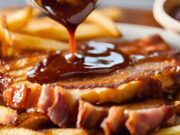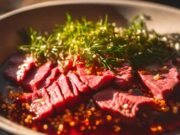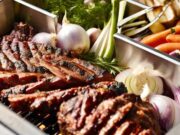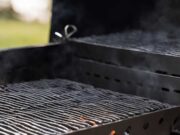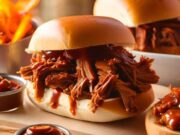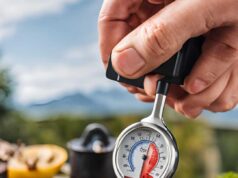- Key Takeaways:
- Tip 1: Test the Thermometer Before Cooking
- Tip 2: Insert in the Correct Location
- Tip 3: Test in Multiple Locations
- Tip 4: Monitor Temperature Early and Often
- Know Your Target Temperatures
- Calibrate Your Meat Thermometer Regularly
- Wait for Temperature to Stabilize
- Clean Your Thermometer Properly
- The Takeaway: Mastering Meat Temperatures
- Additional Resources for Cooking Safety
- Community Feedback and Experience Sharing
- Join Our Community for More Cooking Tips
- Frequently Asked Questions
Cooking meat to perfection relies on reaching the correct internal temperature, and a meat thermometer serves as your most valuable tool in this endeavor.
Whether you are grilling, roasting, or smoking, mastering the use of this essential instrument will enhance your culinary expertise.
This article provides key tips for ensuring accurate temperature readings, including how to test your thermometer’s calibration and the target temperatures for various types of meat.
By exploring these best practices, you will be equipped to serve delicious and safe meals consistently.
Key Takeaways:
- Test your thermometer before cooking to ensure accuracy.
- Insert the thermometer in the correct location for the most precise reading.
- Monitor temperature frequently and in multiple locations for even cooking.
Tip 1: Test the Thermometer Before Cooking
Before embarking on your cooking journey, it is essential to test your thermometer for accuracy to ensure you achieve the desired cooking temperature and prevent foodborne illness. Whether you are using an instant-read thermometer, digital thermometer, or a traditional dial thermometer, calibration is vital for accurate readings.
An accurate thermometer serves as your first line of defense against undercooked or improperly stored foods that can pose serious health risks. To perform a calibration check, you can start with the boiling water method:
- Bring a pot of water to a rolling boil and insert the thermometer’s probe; it should read 212°F (100°C) at sea level.
Alternatively, you can use the ice water method by filling a glass with crushed ice and water. Wait a few minutes, then insert the thermometer; it should read 32°F (0°C).
Regular checks using these methods will ensure you have confidence in your thermometer’s readings, keeping your meals safe and delicious.
Tip 2: Insert in the Correct Location
To ensure accurate readings, it is essential to insert the thermometer in the correct location—specifically, the thickest part of the meat—where it will provide the most reliable internal temperature. This placement is particularly important for various types of meat, including steak, poultry, and others.
For example, when checking beef, aim for the center of the cut, avoiding any bone or fat to prevent skewed results. In the case of chicken, measuring at the thickest part of the breast or thigh will yield accurate readings, while pork should be assessed in the center of the loin or shoulder, ensuring that the thermometer does not touch bone. For lamb, test the leg or rack in the meatiest section, and when cooking fish, focus on the thickest part near the bone for precision.
Always insert the thermometer horizontally into the meat, ensuring it is deep enough for an accurate reading. Maintain a safe cooking environment by being vigilant about cross-contamination and using a clean thermometer each time.

Tip 3: Test in Multiple Locations
For optimal results, it is advisable to test the internal temperature at multiple locations within the meat to ensure even cooking and achieve the desired level of doneness. This practice confirms that the food is cooked properly, thereby reducing the risk of foodborne illness.
By measuring the temperature at various points, especially in larger cuts like roasts, you can ensure that all sections reach the optimal level of doneness. This approach minimizes the chances of any undercooked areas that may harbor harmful bacteria.
Utilizing food thermometers not only enhances safety but also promotes a superior culinary experience, allowing the flavors to fully develop and the textures to remain tender. It is recommended to check the thicker parts of the meat as they generally take longer to cook.
Keep in mind that spending a few extra moments verifying the temperatures can lead to delicious and safe meals every time.
Tip 4: Monitor Temperature Early and Often
Monitoring the temperature frequently during the cooking process is a best practice that helps you remain informed about cooking times and ensures that the meat reaches the appropriate safety temperature without being overcooked. This proactive approach allows you to adjust your cooking methods as needed to achieve optimal results.
Regularly checking the internal temperature with a reliable food thermometer enables you to assess your progress effectively, leading to enhanced cooking techniques and increased confidence in the kitchen. By understanding how different cooking methods—whether grilling, roasting, or sautéing—affect temperature, you can fine-tune your approach for each dish.
This attentive practice not only ensures food safety but also aids in achieving the perfect level of doneness, resulting in juicy, flavorful meals consistently. Moreover, it fosters the development of culinary skills through informed decisions, making the cooking process a more enjoyable and rewarding experience.
Know Your Target Temperatures
Understanding the target temperatures for various types of meat is essential for cooking safely and effectively. This knowledge ensures that foods such as chicken, pork, beef, lamb, and fish reach their appropriate internal temperatures, which is critical for proper cooking and reducing the risk of foodborne illness.
By adhering to these specific temperature guidelines, you can enhance the flavor and texture of the meat while safeguarding against harmful pathogens. For example, poultry should reach an internal temperature of 165°F to eliminate the risk of salmonella. Ground meats like beef or pork need to reach at least 160°F, while larger cuts of beef, lamb, or pork are best cooked to 145°F, allowing for a resting period for added safety. Fish should also be cooked to 145°F to ensure it is both palatable and safe.
Recognizing these vital cooking temperatures is integral to ensuring each meal is not only delicious but also safe for consumption.
Calibrate Your Meat Thermometer Regularly
Regular calibration of your meat thermometer is essential for maintaining reading accuracy and ensuring that your digital devices reliably monitor cooking temperatures. This practice helps prevent discrepancies in temperature readings that could lead to improperly cooked food.
To begin the calibration process, start with boiling water, ensuring it reaches a rolling boil. Submerging the thermometer probe in the boiling water for a few moments allows you to check if it accurately reads 212°F (100°C).
Next, prepare an ice water bath using crushed ice and a bit of water, aiming for a temperature of 32°F (0°C). Immersing the probe in this solution enables further verification of accuracy.
It is crucial to clean the thermometer thoroughly between these two steps to avoid cross-contamination and ensure that readings remain precise. Regularly calibrating this device not only enhances your cooking outcomes but also maintains the integrity of your culinary creations.
Wait for Temperature to Stabilize
After inserting the thermometer, it is essential to wait for the temperature to stabilize before taking the final reading. This ensures that you obtain an accurate temperature measurement for your cooking results. Stabilization is particularly important when using a digital thermometer or a temperature gauge.
Typically, a wait of 10 to 30 seconds is recommended to allow the device to accurately reflect the true temperature of the food or liquid being tested. Rushing this step may lead to incorrect readings that could compromise the doneness of meats, the safety of dishes, or the overall quality of your cooking results.
By allowing the thermometer a moment to stabilize, you can ensure that the reading reflects an accurate temperature, which is crucial for achieving perfectly cooked meals and avoiding foodborne illnesses.
Clean Your Thermometer Properly
Maintaining hygiene and kitchen safety involves ensuring that you properly clean your thermometer after each use to prevent cross-contamination and guarantee food safety in your cooking. Adopting best practices for thermometer cleanliness is essential for any cooking enthusiast.
To achieve this, it is crucial to identify the type of thermometer you are using, as each one requires specific cleaning methods to maintain its integrity and precision. Digital thermometers typically need to be wiped down with a sanitizing solution or hot, soapy water, while probe thermometers may require a thorough wash to remove any food particles that can harbor bacteria. For infrared thermometers, it is vital to ensure that the lens is free from smudges or residue to achieve accurate readings.
Implementing these cleaning practices not only promotes sanitation but also significantly reduces the risk of foodborne illnesses, ensuring a safe and enjoyable cooking experience.
The Takeaway: Mastering Meat Temperatures
Mastering meat temperatures is essential for achieving optimal cooking results and ensuring that your meals are properly cooked, safe to eat, and enjoyable for your family. By adhering to these food thermometer tips and guidelines, you can significantly enhance your cooking experience.
Understanding the ideal temperatures for various meats not only enhances flavor but also guarantees safety, as improper cooking can lead to foodborne illnesses. Whether you are cooking poultry, beef, pork, or lamb, precise monitoring is crucial for consistently flavorful and tender results. For example, a perfectly cooked steak at the right internal temperature can transform an ordinary meal into a culinary delight, while poultry requires careful attention to ensure safety for consumption.
By integrating these practices into your routine, you will not only master the art of cooking meat but also impress those you serve, creating memorable dining experiences.
Additional Resources for Cooking Safety
For those seeking to enhance their knowledge of cooking safety, numerous resources are available that provide guidelines and tips for effectively using food thermometers, including customer service support from brands like ThermoPro.
Plus visiting manufacturer websites, you can benefit from online cooking safety guides that outline best practices for food safety. For instance, the USDA’s Food Safety and Inspection Service offers valuable insights on safe cooking temperatures for various meats.
Another useful resource is the website of the Food and Drug Administration (FDA), which provides comprehensive information on safe food handling and preparation techniques.
Many thermometer manufacturers, such as Taylor and Polder, also offer customer service contacts and user manuals that include troubleshooting tips and cooking charts specifically designed for their devices.
Utilizing these resources not only enhances your cooking skills but also ensures that meals are prepared safely for your family and friends.
Community Feedback and Experience Sharing
Encouraging community feedback and experience sharing can significantly enhance your collective understanding of effective cooking tips, particularly when it comes to using meat thermometers for various recipes and types of meat.
By exchanging stories and insights, home cooks can uncover the nuances of temperature precision, leading to improved outcomes in the kitchen. Whether discussing the optimal internal temperature for a perfectly cooked steak or sharing tips for using thermometers with different cuts of meat, each contribution adds value.
You are invited to share your personal experiences, challenges, or unique techniques that may assist others navigating the world of meat preparation. Together, you can foster a supportive community that not only enhances cooking skills but also transforms the often daunting process of meal preparation into a rewarding experience.
Join Our Community for More Cooking Tips
Joining our community allows you to receive regular updates and tips on cooking, including effective techniques for using kitchen tools such as ThermoPro food thermometers. This will help you create delicious meals safely and efficiently for your family.
By signing up for our newsletter or following our social media channels, you will gain access to a wealth of resources designed for both novice and experienced cooks. Picture yourself as part of a vibrant cooking community where you can share experiences, gather innovative recipes, and learn from others while honing your culinary skills.
The advantages of connecting with like-minded individuals extend beyond just learning; you will also benefit from invaluable customer service insights from top brands, enhancing your cooking journey. Don’t miss this opportunity; join us today and elevate your cooking expertise.
Frequently Asked Questions
What is the best way to ensure accurate temperature readings with a meat thermometer?
The best way to ensure accurate temperature readings with a meat thermometer is to calibrate it before each use. This can be done by using an ice bath or boiling water, depending on the type of thermometer you have.
What is the ideal temperature range for cooking different types of meat?
The ideal temperature range for cooking different types of meat varies, but generally, poultry should be cooked to an internal temperature of 165°F, beef to 145°F, and pork to 160°F. Refer to a cooking temperature chart for specific recommendations for different cuts of meat.
Do I need to insert the meat thermometer in a specific spot for an accurate reading?
Yes, the meat thermometer should be inserted into the thickest part of the meat, avoiding any bones or fat. This will give you the most accurate reading of the internal temperature of the meat.
How long should I wait to take the temperature of the meat?
It is important to wait until the meat has been removed from the heat source for at least 10-15 seconds before taking the temperature. This allows the thermometer to get an accurate reading without being affected by the heat of the cooking process.
Can I use a meat thermometer for non-meat food items?
Yes, a meat thermometer can also be used for non-meat food items, such as baked goods or casseroles. Just make sure to clean and sanitize the thermometer before and after each use to avoid cross-contamination.
What should I do if my meat thermometer does not have a digital display?
If your meat thermometer does not have a digital display, it is important to read the temperature correctly. Make sure to read the temperature at eye level and wait for the thermometer to stop moving to get an accurate reading.








